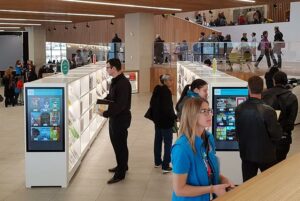Introduction
In a time when technology integrates effortlessly into all aspects of our daily lives, the advanced integration of audio and visual systems elevates regular spaces into engaging and immersive environments. Presented by BCS Consultants, this article provides an in-depth examination of AV integration, covering its essential components, its importance, and its continuously developing trends.
Definition of AV Integration
Audio Visual (AV) Integration involves the seamless combination of audio, video, and control systems into a unified solution. This technology enables individuals and organizations to communicate, collaborate, and present information more effectively and efficiently.
Significance in Today's Technology Landscape
In today's fast-paced world, the significance of AV integration cannot be overstated. It plays a crucial role in enhancing the way we interact with technology, ensuring that information is delivered in a clear, concise, and engaging manner.
Purpose of the Blog
This blog aims to demystify AV integration, shedding light on its components, importance, benefits, and the future trends that are shaping this field. Whether you are a business owner, an educator, or simply a technology enthusiast, understanding the basics of AV integration will help you appreciate its impact on our daily lives and the potential it holds for the future.
Key Components of AV Integration
Audio Components
- Speakers amplify sound, ensuring it reaches every room corner, an essential aspect of audio-visual systems integration.
- Microphones capture audio, allowing for clear communication and interaction, which is crucial for commercial AV integration.
- Amplifiers boost the audio signal, providing the necessary volume without distortion, showcasing the sophistication of this integration.
Visual Components
- Displays offer a visual medium for information and entertainment, a key element of audio-visual integration.
- Projectors enlarge visuals to fit screens of any size, making them ideal for large venues and integral to AV integration.
- Screens provide the canvas for projected images, essential for high-quality viewing experiences by integrating audio-visual systems.
Control Systems
- Interfaces allow users to interact with the AV system, offering ease of control and exemplifying the convenience of AV integration.
- Controllers manage the various components of the AV system, ensuring they work in unison, a critical factor in successful audio-visual systems integration.
- Software integrates the hardware components, enabling customized control over the AV experience, highlighting commercial AV integration's technological prowess.
Importance of AV Integration in Various Settings
Corporate Environments
AV integration facilitates effective presentations, meetings, and collaborative projects, from conference rooms to boardrooms, making communication seamless.
Educational Institutions
In classrooms and lecture halls, audio-visual integration supports interactive learning, making education more engaging and accessible, a testament to the versatility of this integration.
Entertainment Venues
Theaters and concert halls benefit from AV integration by delivering unforgettable performances, thanks to enhanced sound and visuals—a core advantage of audio-visual systems integration.
Benefits of AV Integration
-
Enhanced Communication
Clear audio and visuals are critical for effective message delivery in any setting, from corporate meetings to educational lectures. Successful AV integration ensures that all participants hear and see presentations clearly, regardless of their location in the room. This clarity enhances the understanding and retention of information, making communication more effective and impactful.
-
Improved Collaboration
Working together efficiently, even remotely, is vital in today's interconnected world. Audio-visual integration facilitates this by providing technology-facilitated environments that encourage teamwork. Whether through video conferencing that brings remote teams together or interactive whiteboards that allow real-time collaboration, this integration breaks down physical barriers to teamwork.
-
Increased Efficiency
Streamlined AV systems significantly save time and resources by reducing the need for manual setup and adjustments. With commercial AV integration, systems can be designed to meet specific needs, enabling users to start meetings or presentations with a button. This automation reduces downtime and increases productivity, allowing businesses and educational institutions to focus on their core objectives.
-
User Experience
High-quality audio-visual integration makes experiences more enjoyable and memorable by providing crisp audio and vivid visuals. In entertainment venues, for example, it can create immersive experiences that transport audiences. In educational settings, interactive and multimedia content can make learning more engaging. The goal is to create environments where technology enhances the overall experience.

Challenges in AV Integration
-
Compatibility Issues
One of the biggest challenges in AV integration is ensuring all components work together seamlessly. This includes compatibility between different brands, technologies, and legacy systems. Addressing these compatibility issues requires thorough planning and sometimes custom solutions, which can be a hurdle for organizations without the right expertise.
-
Technical Challenges
The setup and optimization of AV systems are complex processes that require a deep understanding of the technology and the environment in which it's being implemented. Challenges can arise from the acoustics of a room, lighting conditions, and even the specific needs of the users. Overcoming these technical challenges often requires the skills of experienced AV integrators.
-
Maintenance and Upkeep
Regular maintenance and updates are necessary to ensure the longevity and reliability of AV systems. This includes firmware updates, hardware checks, and troubleshooting any issues. Neglecting maintenance can lead to system failures at critical moments, undermining the benefits of AV integration.
Future Trends in AV Integration
-
Emerging Technologies
Technologies like Artificial Intelligence (AI), Augmented Reality (AR), and Virtual Reality (VR) are poised to revolutionize audio-visual integration by introducing new ways to interact with digital content. These technologies can make experiences more personalized and interactive, from AI-driven customized learning experiences in education to immersive virtual environments in entertainment.
-
Integration with Smart Devices
The trend towards integrating AV systems with smart devices enhances user control and interaction. Users can control AV systems from their smartphones or tablets, making it easier to manage presentations, adjust lighting, or change the volume. This seamless connectivity is becoming expected in modern AV solutions.
-
Sustainable AV Integration Solutions
As environmental concerns become more pressing, sustainable AV integration solutions are gaining traction. This includes using energy-efficient components, recyclable materials, and systems to minimize power consumption. The move towards sustainability is not just about reducing environmental impact but also about reducing long-term operational costs.
Tips for Successful AV Integration
-
Comprehensive Needs Assessment
Understanding the specific AV needs of your space is crucial for successful integration. This involves considering the size of the space, the number of users, the types of activities that will take place, and any unique challenges. A comprehensive needs assessment ensures that the AV system is tailored to meet these needs effectively.
-
Collaboration with Experienced Integrators
Partnering with professionals like BCS Consultants is essential for achieving the best results in AV integration. Experienced integrators bring a wealth of knowledge and expertise, ensuring that the design and implementation of the AV system address both current needs and future growth. Their insight can help avoid common pitfalls and ensure that the system is scalable and adaptable.
-
Regular Maintenance and Updates
Keeping your AV system up-to-date and in top condition is vital for its longevity and reliability. Routine maintenance and updates can prevent unexpected failures and extend the system's life. This includes software updates, hardware checks, and the calibration of audiovisual equipment to ensure optimal performance.

Conclusion
AV integration is more than a technological advancement; it's vital to modern communication, education, and entertainment. By understanding its essential elements, benefits, and challenges, you can better navigate the complexities of this integration. As we look towards a future where technology continues to evolve, embracing this technology is essential for creating engaging, efficient, and impactful environments. BCS Consultants is at the forefront of this technological evolution, ready to guide you through the intricacies of audio-visual integration and unlock the full potential of your space.
If you're ready to transform your space with the power of AV integration, we invite you to call BCS Consultants for a consultation or visit our website for more solutions. Call us at +1 949-333-1000 for more information.
FAQs
FAQ 1: Can AV Integration Support Remote Participants in Hybrid Events?
Answer: Absolutely! AV integration is designed to bridge the gap between in-person and remote participants, ensuring seamless interaction during hybrid events. With the proper AV setup, remote attendees can engage in real-time, contributing to discussions, polls, and Q&As, making them feel as if they're right there in the room. Our solutions include high-definition video conferencing, transparent audio systems, and interactive tools to support dynamic participation from anywhere in the world.
FAQ 2: How Can AV Integration Enhance Branding in Corporate Spaces?
Answer: Innovatively! AV integration offers unique opportunities to reinforce your brand identity within corporate spaces. Your AV setup can become a powerful tool for brand reinforcement through customized digital signage, interactive displays, and even branded user interfaces on control systems. Dynamic content such as welcome messages, company achievements, and real-time news can be displayed, creating a lasting impression on employees and visitors alike.
FAQ 3: Are There Energy-Efficient AV Solutions for Eco-Conscious Organizations?
Answer: Definitely! For organizations keen on sustainability, energy-efficient AV solutions are a top priority. We specialize in designing AV systems that minimize energy consumption without compromising performance. This includes LED lighting, low-power consumption displays, and intelligent systems that automatically adjust based on room occupancy or time of day. By choosing eco-friendly AV solutions, you're reducing your carbon footprint and potentially lowering your energy costs in the long run.


You must be logged in to post a comment.